DeWalt DW138 Handleiding
DeWalt
Boormachine
DW138
Bekijk gratis de handleiding van DeWalt DW138 (5 pagina’s), behorend tot de categorie Boormachine. Deze gids werd als nuttig beoordeeld door 52 mensen en kreeg gemiddeld 4.5 sterren uit 26.5 reviews. Heb je een vraag over DeWalt DW138 of wil je andere gebruikers van dit product iets vragen? Stel een vraag
Pagina 1/5

Minimum Gage for Cord Sets
Volts Total Length of Cord in Feet
120V 0-25 26-50 51-100 101-150
240V 0-50 51-100 101-200 201-300
Ampere Rating
More Not more AWG
Than Than
6 - 10 18 16 14 12
10 - 12 16 16 14 12
•OUTDOOR USE EXTENSION CORDS. When tool is used outdoors, use only extension
cords intended for use outdoors and so marked.
•STAY ALERT. Watch what you are doing. Use common sense. Do not operate tool when you
are tired.
•CHECK DAMAGED PARTS. Before further use of the tool, a guard or other part that is dam-
aged should be carefully checked to determine that it will operate properly and perform its
intended function. Check for alignment of moving parts, binding of moving parts, breakage
of parts, mounting, and any other conditions that may affect its operation. A guard or other
part that is damaged should be properly repaired or replaced by an authorized service cen-
ter unless otherwise indicated elsewhere in this instruction manual. Have defective switches
replaced by authorized service center. Do not use tool if switch does not turn it on and off.
CAUTION: Wear appropriate personal hearing protection during use. Under some con-
ditions and duration of use, noise from this product may contribute to hearing loss.
CAUTION: When drilling or driving into walls, floors or wherever live electrical wires may be
encountered, DO NOT TOUCH ANY METAL PARTS OF THE TOOL! Hold the tool only by insu-
lated grasping surfaces to prevent electric shock if you drill or drive into a live wire.
WARNING: Some dust created by power sanding, sawing, grinding, drilling, and other con-
struction activities contains chemicals known to cause cancer, birth defects or other reproduc-
tive harm. Some examples of these chemicals are:
• lead from lead-based paints,
• crystalline silica from bricks and cement and other masonry products, and
• arsenic and chromium from chemically-treated lumber (CCA).
Your risk from these exposures varies, depending on how often you do this type of work. To
reduce your exposure to these chemicals: work in a well ventilated area, and work with
approved safety equipment, such as those dust masks that are specially designed to filter out
microscopic particles.
•Avoid prolonged contact with dust from power sanding, sawing, grinding, drilling, and
other construction activities. Wear protective clothing and wash exposed areas with
soap and water. Allowing dust to get into your mouth, eyes, or lay on the skin may promote
absorption of harmful chemicals.
WARNING: Use of this tool can generate and/or disburse dust, which may cause serious and
permanent respiratory or other injury. Always use NIOSH/OSHA approved respiratory protection
appropriate for the dust exposure. Direct particles away from face and body.
• The label on your tool may include the following symbols.
V................volts A ..................amperes
Hz..............hertz W..................watts
min ............minutes ................alternating current
..........direct current no ................no load speed
..............Class II Construction …/min ..........revolutions or reciprocation per minute
..............earthing terminal ................safety alert symbol
Grounding Instructions
This tool should be grounded while in use to protect the operator from electric shock. The tool
is equipped with a 3-conductor cord and 3-prong grounding type plug to fit the proper ground-
ing type receptacle. The green (or green and yellow) conductor in the cord is the grounding wire.
Never connect the green (or green and yellow) wire to a live terminal. If your unit is intended for
use on less than 150 V, it has a plug that looks like that shown in sketch A. If it is for use on 150
to 250 V, it has a plug that looks like that shown in sketch D. An adapter, sketches B and C, is
available for connecting sketch A type plugs to 2-prong receptacles. The green-colored rigid ear,
lug, or the like, extending from the adapter must be connected to a permanent ground, such as
a properly grounded outlet box. No adapter is available for a plug as shown in sketch D.
ADAPTER SHOWN IN FIGURES B and C IS NOT FOR USE IN CANADA.
SAVE THESE INSTRUCTIONS
Motor
Your DEWALT tool is powered by a D WALT built motor. Be sure your power supply agrees withE
the nameplate marking. The markings; 120 volts, 50/60 Hz or “AC/DC”, mean that your drill will
operate on alternating or direct current.Voltage decrease of more than 10% will cause loss of
power and overheating. All DEWALT tools are factory tested; if this tool does not operate, check
the power supply.
Side Handle
To install the side handle, use the metal plate, four screws and four lock washers included with
the unit. Install the plate with the screws as shown in Figure 1. Tighten all screws securely.
Screw the threaded end of the side handle into the plate and tighten securely.
CAUTION: Always use and hold firmly the side handle or spade handle. This is a high-torque
drill: always hold it with both hands when operating. The side handle screws into the large hole
in the top of the tool.
Switch
To turn the tool ON, depress the trigger switch. To turn the tool OFF, release the trigger switch.
(See Figure 2).
The toggle switch above the trigger is the
reversing switch
. Switch this toggle only when the
tool is not running or coasting. After reversing operations are completed, switch the toggle back
to forward position.
To lock the tool ON, depress the trigger and push in the
lock button
. Then, while holding the
lock button in position, gently release the trigger. To release locking mechanism, depress trig-
ger fully, then release it. Do not lock the switch ON when drilling by hand so that you can instant-
ly release the trigger switch if the bit binds in the hole. The locking feature is for use when the
drill is mounted in a drill stand or otherwise firmly held. THE LOCKING FEATURE IS NOT FOR
USE WHEN DRILLING BY HAND. Be sure to release the switch lock button before discon-
necting the tool from the power supply. Failure to do so will cause the tool to start immediately
the next time it is plugged in. Damage or injury could result.
For reversing operation, turn the tool off and wait for it to stop coasting. Grasp the reversing ring
(Fig. 3) and turn it counterclockwise until the raised indicator aligns with the word REVERSE.
Chuck
To insert bit,
open chuck jaws by turning collar with fingers and insert shank of bit about 3/4"
(19mm) into chuck. Tighten chuck collar by hand. Place chuck key in each of the three holes
and tighten in clockwise direction. It’s important to tighten chuck with all three holes.
To release
bit
, turn chuck key counterclockwise in just one hole, then loosen the chuck by hand.
Chuck Removal
1. turn off tool and DISCONNECT FROM POWER SUPPLY.
2. Place chuck key in chuck.
A B C
GROUNDING PIN
GROUNDED
OUTLET
BOX GROUNDING
MEANS
ADAPTER GROUNDING PIN
D
INSTRUCTION MANUAL
GUIDE D'UTILISATION
MANUAL DE INSTRUCCIONES
INSTRUCTIVO DE OPERACIÓN, CENTROS DE SERVICIO Y PÓLIZA
DE GARANTÍA. LÉASE ESTE INSTRUCTIVOADVERTENCIA:
ANTES DE USAR EL PRODUCTO.
DEWALT Industrial Tool Co., 701 East Joppa Road, Baltimore, MD 21286
(OCT05) Form No. 637575-00 DW138, DW138-220, DW139
Copyright © 1998, 2002, 2003, 2005 DEWALT
The following are trademarks for one or more DEWALT power tools: the yellow and black color scheme; the
“D” shaped air intake grill; the array of pyramids on the handgrip; the kit box configuration; and the array of
lozenge-shaped humps on the surface of the tool.
DW138, DW138-220, DW139
3/4" and 5/8" (13mm and 17mm) Spade Handle Drills
Perceuses de 13 mm et 17mm (3/4 et 5/8 po) à poignée-bêche
Taladros 13 mm y 17mm (3/4 "y 5/8") Mango tipo espada
If you have questions or comments, contact us.
Pour toute question ou tout commentaire, nous contacter.
Si tiene dudas o comentarios, contáctenos.
1-800-4-DEWALT • www.dewalt.com
IF YOU HAVE ANY QUESTIONS OR COMMENTS ABOUT THIS OR ANY DEWALT TOOL,
CALL US TOLL FREE AT: 1-800-4-DEWALT (1-800-433-9258)
Important Safety Instructions
WARNING: When using electric tools, basic safety precautions should always be followed
to reduce risk of fire, electric shock, and personal injury, including the following:
READ ALL INSTRUCTIONS
Safety Instructions For All Tools
•KEEP WORK AREA CLEAN. Cluttered areas and benches invite injuries.
•CONSIDER WORK AREA ENVIRONMENT. Don’t expose power tools to rain. Don’t use
power tools in damp or wet locations. Keep work area well lit. Do not use tool in presence of
flammable liquids or gases.
•GUARD AGAINST ELECTRIC SHOCK. Prevent body contact with grounded surfaces. For
example; pipes, radiators, ranges, and refrigerator enclosures.
•KEEP CHILDREN AWAY. Do not let visitors contact tool or extension cord. All visitors should
be kept away from work area.
•STORE IDLE TOOLS. When not in use, tools should be stored in dry, and high or locked-up
place — out of reach of children.
•DON’T FORCE TOOL. It will do the job better and safer at the rate for which it was intended.
•USE RIGHT TOOL. Don’t force small tool or attachment to do the job of a heavy-duty tool.
Don’t use tool for purpose not intended.
•DRESS PROPERLY. Do not wear loose clothing or jewelry. They can be caught in moving
parts. Rubber gloves and non-skid footwear are recommended when working outdoors. Wear
protective hair covering to contain long hair. Air vents often cover moving parts and should
also be avoided.
•USE SAFETY GLASSES. Also use face or dust mask if operation is dusty.
•DON’T ABUSE CORD. Never carry tool by cord or yank it to disconnect from receptacle.
Keep cord from heat, oil, and sharp edges.
•SECURE WORK. Use clamps or a vise to hold work. It’s safer than using your hand and it
frees both hands to operate tool.
•DON’T OVERREACH. Keep proper footing and balance at all times.
•MAINTAIN TOOLS WITH CARE. Keep tools sharp and clean for better and safer perfor-
mance. Follow instructions for lubricating and changing accessories. Inspect tool cords peri-
odically and if damaged, have repaired by authorized service facility. Inspect extension cords
periodically and replace if damaged. Keep handles dry, clean, and free from oil and grease.
•DISCONNECT OR LOCK OFF TOOLS when not in use, before servicing, and when chang-
ing accessories, such as blades, bits, cutters.
•REMOVE ADJUSTING KEYS AND WRENCHES. Form habit of checking to see that keys
and adjusting wrenches are removed from tool before turning it on.
•AVOID UNINTENTIONAL STARTING. Don’t carry tool with finger on switch. Be sure switch
is off when plugging in.
•EXTENSION CORDS. Use only 3-wire extension cords that have 3-prong grounding-type
plugs and 3-pole receptacles that accept the tool’s plug. Replace or repair damaged cords.
Make sure your extension cord is in good condition. When using an extension cord, be sure
to use one heavy enough to carry the current your product will draw. An undersized cord will
cause a drop in line voltage resulting in loss of power and overheating. The following table
shows the correct size to use depending on cord length and nameplate ampere rating. If in
doubt, use the next heavier gage. The smaller the gage number, the heavier the cord.

3. Using a wooden mallet or similar object, strike key sharply in a clockwise direction. This will
loosen screw inside chuck.
4. Open chuck jaws fully. Insert screwdriver (or 3/16", 5mm, hex wrench if required) into front
of chuck between jaws to engage screw head.
5. Remove screw by turning clockwise (left-hand thread).
6. Place key in chuck.
7. Using a wooden mallet or similar object, strike key sharply in a counterclockwise direction
(Fig. 4). This will loosen chuck so that it can be unscrewed by hand.
Drilling
1. Always turn off tool and disconnect from power supply when attaching or changing bits or
accessories.
2. Use sharp drill bits only. For WOOD, use twist drill bits, spade bits, power auger bits, or hole
saws. For METAL, use high speed steel twist drill bits or hole saws. For MASONRY, such as
brick, cement, cinder block, etc., use carbide-tipped bits
3. Be sure the material to be drilled is anchored or clamped firmly. If drilling thin material, use
a “back-up” block to prevent damage to the material.
4. Always apply pressure in a straight line with the bit. Use enough pressure to keep the drill
bit biting, but do not push hard enough to stall the motor or deflect the bit.
5. Hold tool firmly to control the twisting action of the drill.
6. IF DRILL STALLS, it is usually because it is being overloaded. RELEASE TRIGGER IMME-
DIATELY, remove drill bit from work, and determine cause of stalling. DO NOT CLICK TRIG-
GER ON AND OFF IN AN ATTEMPT TO START A STALLED DRILL – THIS CAN DAM-
AGE THE DRILL.
7. To minimize stalling on breaking through the material, reduce pressure on drill and ease the
bit through the last fractional part of the hole.
8. Keep the motor running when pulling the bit back out of a drilled hole. This will help prevent
jamming.
DRILLING IN WOOD
Holes in wood can be made with the same twist drills used for metal. These bits may overheat
unless pulled out frequently to clear chips from the flutes. For larger holes, use spade bits, power
auger bits, or hole saws. Work that is likely to splinter should be backed up with a block of wood.
DRILLING IN METALS
Use a cutting lubricant when drilling metals. The exceptions are cast iron and brass which should
be drilled dry. The cutting lubricants that work best are sulphurised cutting oil or lard oil; bacon
grease will also serve the purpose.
DRILLING IN MASONRY
Use carbide tipped masonry bits at low speeds. Keep even force on the drill but not so much
that you crack the brittle materials. A smooth, even flow of dust indicates the proper drilling rate.
Lubrication
All bearings used are factory lubricated to last the life of the tool. All needle bearings used
receive their lubrication from the grease in the gear case. Clean and relubricate gear case year-
ly or whenever servicing requires the gear case to be removed. Use type and quantity of grease
shown on Parts Bulletin packed with your tool.
Gear case is removed by removing the three screws from the front of the tool. If the chuck is too
large to permit removal of the two top screws, see instructions for chuck removal.
Motor Brushes
TURN OFF TOOL AND DISCONNECT FROM POWER SUPPLY.
To inspect brushes, unscrew the plastic brush inspection caps (located in the sides of the motor
housing) and the spring and brush assemblies may be withdrawn from the tool. Keep brushes
clean and sliding freely in their guides. Carbon brushes have varying symbols stamped into
them, and if the brush is worn down to a point where the symbol is not visible, they must be
replaced. New brush assemblies are available at authorized service centers.
Accessories
Recommended accessories for use with your tool are available at extra cost from your local deal-
er or authorized service center. If you need assistance in locating any accessory for your tool,
please contact DEWALT Industrial Tool Co., 701 East Joppa Road, Baltimore, MD 21286, call 1-
800-4-DEWALT (1-800-433-9258) or visit our website www.dewalt.com.
CAUTION: The use of any other accessory not recommended for use with this tool could be
hazardous.
For safety in use, the following accessories should be used only in sizes up to the maximums
shown in the table below.
MAXIMUM RECOMMENDED CAPACITIES
Drill Capacity 1/2" 13mm 1/2" 13mm
RPM 0-450 0-1000
Steel twist bit 1/2" 13mm 1/2" 13mm
Auger 1-1/2" 38mm 1-1/2" 38mm
Self-feed 3" 76mm 1-3/4" 45mm
Spade 1-1/2" 38mm 1-1/2" 38mm
Wood holesaw 5" 127mm 3" 76mm
Steel holesaw 4" 102mm 1-1/2" 38mm
ACCESSORY MUST BE RATED FOR USE AT SPEED EQUAL TO OR HIGHER THAN NAME-
PLATE RPM OF TOOL WITH WHICH IT IS BEING USED.
Repairs
To assure product SAFETY and RELIABILITY, repairs, maintenance and adjustment (including
brush inspection and replacement) should be performed by a DEWALT factory service center, a
DEWALT authorized service center or other qualified service personnel. Always use identical
replacement parts.
Three Year Limited Warranty
DEWALT will repair, without charge, any defects due to faulty materials or workmanship for three
years from the date of purchase. This warranty does not cover part failure due to normal wear
or tool abuse. For further detail of warranty coverage and warranty repair information, visit
www.dewalt.com or call 1-800-4-DEWALT (1-800-433-9258). This warranty does not apply to
accessories or damage caused where repairs have been made or attempted by others. This
warranty gives you specific legal rights and you may have other rights which vary in certain
states or provinces.
In addition to the warranty, DEWALT tools are covered by our:
1 YEAR FREE SERVICE
DEWALT will maintain the tool and replace worn parts caused by normal use, for free, any time
during the first year after purchase.
90 DAY MONEY BACK GUARANTEE
If you are not completely satisfied with the performance of your DEWALT Power Tool, Laser, or
Nailer for any reason, you can return it within 90 days from the date of purchase with a receipt
for a full refund – no questions asked.
LATIN AMERICA: This warranty does not apply to products sold in Latin America. For products
sold in Latin America, see country specific warranty information contained either in the packag-
ing, call the local company or see website for warranty information.
RECONDITIONED PRODUCT: Reconditioned product is covered under the 1 Year Free Service
Warranty. The 90 Day Money Back Guarantee and the Three Year Limited Warranty do not apply
to reconditioned product.
FREE WARNING LABEL REPLACEMENT: If your warning labels become illegible or are miss-
ing, call 1-800-4-DEWALT for a free replacement.
POUR TOUT RENSEIGNEMENT SUPPLÉMENTAIRE SUR CET OUTIL OU TOUT AUTRE
OUTIL DEWALT, COMPOSER SANS FRAIS LE NUMÉRO:
1 800 4-DEWALT (1 800 433-9258)
Importantes mesures de sécurité
AVERTISSEMENT : Afin de réduire les risques d’incendie, de secousses électriques ou
de blessures lorsqu’on utilise des outils électriques, il faut toujours respecter les mesures
de sécurité suivantes.
LIRE TOUTES LES DIRECTIVES.
Mesures de sécurité pour tous les outils
•BIEN DÉGAGER LA SURFACE DE TRAVAIL. Des surfaces et des établis encombrés peu-
vent être la cause de blessures.
•TENIR COMPTE DU MILIEU DE TRAVAIL. Protéger les outils électriques de la pluie. Ne
pas s’en servir dans des endroits humides ou mouillés. Bien éclairer la surface de travail. Ne
pas se servir de l’outil en présence de liquides ou de vapeurs inflammables.
•SE PROTÉGER CONTRE LES SECOUSSES ÉLECTRIQUES. Éviter tout contact avec des
objets mis à la terre, comme des tuyaux, radiateurs, cuisinières, réfrigérateurs et autres
objets du genre.
•ÉLOIGNER LES ENFANTS. Tous les visiteurs doivent être tenus à l’écart de l’aire de travail
et il faut les empêcher de toucher à l’outil ou au cordon de rallonge.
•RANGER LES OUTILS INUTILISÉS. Il faut ranger les outils dans un endroit sec, situé en
hauteur ou fermé à clé, hors de la portée des enfants.
•NE JAMAIS FORCER L’OUTIL. Afin d’obtenir un rendement sûr et efficace, utiliser l’outil à
son rendement nominal.
•UTILISER L’OUTIL APPROPRIÉ. Ne jamais exiger d’un petit outil ou d’un accessoire le ren-
dement d’un outil de fabrication plus robuste. Se servir de l’outil selon l’usage prévu.
•PORTER DES VÊTEMENTS APPROPRIÉS. Éviter de porter des vêtements amples et des
bijoux qui peuvent être happés par les pièces en mouvement. Porter des gants de
caoutchouc et des chaussures à semelle antidérapante pour travailler à l’extérieur. Protéger
la chevelure si elle est longue.
•PORTER DES LUNETTES DE SÉCURITÉ. Porter également un masque respiratoire si le
travail de coupe produit de la poussière.
•NE PAS MANIPULER LE CORDON DE FAÇON ABUSIVE. Ne pas transporter l’outil par le
cordon ni tirer sur ce dernier pour le débrancher de la prise. Éloigner le cordon des sources
de chaleur, des flaques d’huile et des arêtes tranchantes.
•ASSUJETTIR LA PIÈCE. Immobiliser la pièce à l’aide de brides ou d’un étau. On peut alors
se servir des deux mains pour faire fonctionner l’outil, ce qui est plus sûr.
•NE PAS DÉPASSER SA PORTÉE. Toujours demeurer dans une position stable et garder
son équilibre.
•PRENDRE SOIN DES OUTILS. Conserver les outils propres pour qu’ils donnent un rende-
ment supérieur et sûr. Suivre les directives concernant la lubrification et le remplacement des
accessoires. Inspecter régulièrement le cordon de l’outil et le faire réparer au besoin à un
atelier d’entretien autorisé. Inspecter régulièrement les cordons de rallonge et les remplacer
lorsqu’ils sont endommagés. S’assurer que les poignées sont toujours propres, sèches et
libres de toute tache d’huile ou de graisse.
•DÉBRANCHER OU VERROUILLER EN POSITION HORS TENSION LES OUTILS NON
UTILISÉS. Respecter cette mesure lorsqu’on ne se sert pas de l’outil, ou qu’on doit le répar-
er ou en changer un accessoire (comme une lame, un foret ou un couteau).
•ENLEVER LES CLÉS DE RÉGLAGE. Prendre l’habitude de vérifier si les clés de réglage
ont été retirées avant de faire démarrer l’outil.
•ÉVITER LES DÉMARRAGES ACCIDENTELS. Ne pas laisser le doigt sur l’interrupteur
lorsqu’on transporte l’outil. S’assurer que l’interrupteur est à la position hors circuit lorsqu’on
branche l’outil.
•CORDONS DE RALLONGE. S’assurer que le cordon de rallonge est en bon état. Lorsqu’on
se sert d’un cordon de rallonge, s’assurer qu’il est de calibre approprié pour la tension néces-
saire au fonctionnement de l’outil. L’utilisation d’un cordon de calibre inférieur occasionne
une baisse de tension entraînant une perte de puissance et la surchauffe. Le tableau suiv-
SIDE HANDLE
POIGNÉE LATÉRALE
MANGO LATERAL
FIG. 1
LOCK WASHER
RONDELLE FREIN
CIERRE ARANDELA
SCREWS (PROVIDED)
LES VIS (A FOURNI)
LOS TORNILLOS (PROPORCIONÓ)
METAL PLATE
LA PLAQUE EN MÉTAL
EL PLATO DEL METAL
CHUCK
MANDRIN
PORTABROCAS
BRUSH INSPECTION CAP
BOUCHON D’INSPECTION
DES BALAIS
TAPA DE INSPECCION
DE CARBONES
FIG. 2
TRIGGER SWITCH
INTERRUPTEUR
À DÉTENTE
GATILLO INTERRUPTOR
TRIGGER LOCK BUTTON
BOUTON DE VERROUILLAGE
BOTÓN DE ENCENDIDO
PERMANENTE
SIDE HANDLE
POIGNÉE LATÉRALE
MANGO LATERAL
SPADE HANDLE
POIGNÉE-BÊCHE
MANGO TIPO ESPADA
REVERSE FORWARD
FIG. 3
RAISED INDICATOR
INDICATEUR HAUSSÉ
EL INDICADOR LEVANTADO
REVERSING RING
ANNEAU RENVERSANT
EL ANILLO QUE INVIERTE
FIG. 5
FIG. 4

ant indique le calibre approprié selon la longueur du cordon et les mentions de la plaque sig-
nalétique de l’outil. En cas de doute, utiliser un cordon de calibre supérieur. Le chiffre indi-
quant le calibre est inversement proportionnel au calibre du cordon.
Calibre minimal des cordons de rallonge
Tension Longueur totale du cordon en pieds
120 V 0-25 26-50 51-100 101-150
240 V 0-50 51-100 101-200 201-300
Intensité (A)
Au Au Calibre moyen de fil (AWG)
moins plus
6 - 10 18 16 14 12
10 - 12 16 16 14 12
•CORDONS DE RALLONGE PRÉVUS POUR L’EXTÉRIEUR. Lorsque l’outil est utilisé à
l’extérieur, ne se servir que d’un cordon de rallonge conçu pour l’extérieur et portant la men-
tion appropriée.
•DEMEURER VIGILANT. Travailler avec vigilance et faire preuve de bon sens. Ne pas se
servir de l’outil lorsqu’on est fatigué.
•VÉRIFIER LES PIÈCES ENDOMMAGÉES. Avant de continuer à utiliser l’outil, il faut vérifi-
er si le protecteur ou toute autre pièce endommagée remplit bien la fonction pour laquelle il
a été prévu. Vérifier l’alignement et les attaches des pièces mobiles, le degré d’usure des
pièces et leur montage, ainsi que tout autre facteur susceptible de nuire au bon fonction-
nement de l’outil. Faire réparer ou remplacer tout protecteur ou toute autre pièce endom-
magée dans un centre de service autorisé, sauf si le présent guide fait mention d’un avis con-
traire. Confier le remplacement de tout interrupteur défectueux à un centre de service
autorisé. Ne jamais se servir d’un outil dont l’interrupteur est défectueux.
MISE EN GARDE : Porter un dispositif de protection personnel anti-bruit approprié
durant l’utilisation. Sous certaines conditions et pendant toute la durée de l’utilisation, le bruit
émanant de ce produit pourrait contribuer à la perte d’audition.
MISE EN GARDE : Lorsqu’on perce ou qu’on visse dans les murs, les planchers ou tout autre
endroit où peuvent se trouver des fils sous tension, NE PAS TOUCHER AUX COMPOSANTS
MÉTALLIQUES DE L’OUTIL. Ne le saisir que par ses surfaces en plastique afin de se protéger
des secousses électriques si on entre en contact avec un fil sous tension.
AVERTISSEMENT : Certains outils, tels que les sableuses électriques, les scies, les meules,
les perceuses ou certains autres outils de construction, peuvent soulever de la poussière con-
tenant des produits chimiques susceptibles d’entraîner le cancer, des malformations congéni-
tales ou pouvant être nocifs pour le système reproductif. Parmi ces produits chimiques, on
retrouve :
• le plomb dans les peintures à base de plomb;
• la silice cristalline dans les briques et le ciment et autres produits de maçonnerie;
• l’arsenic et le chrome dans le bois de sciage ayant subi un traitement chimique (CCA).
Le risque associé à de telles expositions peut varier selon la fréquence avec laquelle on effectue
ces travaux. Pour réduire l’exposition à de tels produits, il faut travailler dans un endroit bien ven-
tilé et utiliser l’équipement de sécurité approprié tel un masque anti-poussières spécialement
conçu pour filtrer les particules microscopiques.
•Éviter tout contact prolongé avec la poussière soulevée par cet outil ou autres outils
électriques. Porter des vêtements de protection et nettoyer les parties exposées du
corps avec de l’eau savonneuse. S’assurer de bien se protéger afin d’éviter d’absorber par
la bouche, les yeux ou la peau des produits chimiques nocifs.
AVERTISSEMENT : Cet outil peut produire et répandre de la poussière susceptible de causer
des dommages sérieux et permanents au système respiratoire. Toujours utiliser un appareil res-
piratoire anti-poussières approuvé par le NIOSH ou l’OSHA. Diriger les particules dans le sens
opposé du visage et du corps.
• L’étiquette de l’outil peut comporter les symboles suivants.
V ............volts A ............ampères
Hz ..........hertz W ............watts
/min ........minutes ..........courant alternatif
........courant continu no ..........sous vide
..........construction de classe II /min ........tours ou courses à la minute
..........borne de mise à la terre ..........symbole d´avertissement
Directives concernant la mise à la terre
Cet outil doit être mis à la terre afin de protéger l’utilisateur contre les risques de choc électrique.
Cet outil est doté d’un cordon trifilaire et d’une fiche de terre à trois broches; on doit en raccorder
la fiche dans une prise murale appropriée. Le conducteur vert (ou vert et jaune) du cordon est
le fil de mise à la terre. Ne jamais raccorder le fil vert (ou vert et jaune) à une borne sous ten-
sion. Les outils destinés à être raccordés à un circuit d’alimentation électrique ayant une tension
nominale de moins de 150 volts sont en effet munis d’une fiche qui est semblable à celle illus-
trée à la figure A, alors que ceux destinés à être raccordés à un circuit dont la tension nominale
varie entre 150 et 250 volts sont munis d’une fiche qui ressemble à celle illustrée à la figure D.
On peut utiliser un adaptateur, comme celui illustré aux figures B et C, pour brancher la fiche de
l’outil (figure A) à une prise à deux broches. On doit mettre cet adaptateur à la terre en en reliant
l’oeillet, la cosse ou tout autre dispositif de couleur verte à un élément mis à la terre de manière
permanente, comme une boîte à prises bien mise à la terre. Aucun adaptateur n’est disponible
pour une fiche semblable à celle illustrée à la figure D. IL EST CEPENDANT INTERDIT DE SE
SERVIR D’UN TEL ADAPTATEUR (FIGURES B ET C) AU CANADA.
CONSERVER CES MESURES
Moteur
Un moteur DEWALT actionne l’outil DEWALT. Veiller à ce que la tension d’alimentation soit con-
forme aux exigences de la plaque signalétique de l’outil. Une baisse de tension de plus de
10 p. 100 entraîne une perte de puissance et la surchauffe. Tous les outils DEWALT sont
essayés avant de quitter l’usine. Lorsque celui-ci refuse de fonctionner, vérifier la source de
courant électrique.
Poignée latérale
Pour installer la poignée latéral, utiliser la plaque en métal, quatre vis et quatre rondelles frein
incluses avec l'unité. Installer la plaque avec les vis selon la figure 1. Resserrer toutes vis
assurément. Visser la fin enfilée de la poignée latéral dans la plaque et resserrer assurément.
MISE EN GARDE : Toujours utiliser et bien saisir la poignée latérale ou la poignée-bêche. Il
s’agit d’une perceuse à couple élevé; toujours la saisir à deux mains lorsqu’on s’en sert. La
poignée latérale se visse dans le gros trou sur le dessus de l’outil.
Interrupteur
Pour actionner l’outil, enfoncer l’interrupteur à détente. Pour l’arrêter, relâcher l’interrupteur
à détente (fig. 2).
L’interrupteur à bascule au-dessus de la détente consiste en l’
inverseur de marche
. Se servir
de l’inverseur de marche seulement lorsque l’outil est arrêté. À la fin des travaux en marche
arrière, remettre l’inverseur de marche en position avant.
Pour verrouiller l’outil en mode de fonctionnement, enfoncer la détente ainsi que le
bouton de
verrouillage
. Puis, tout en maintenant le bouton enfoncé, relâcher doucement la détente. Pour
dégager le mécanisme de verrouillage, enfoncer la détente à fond et la relâcher. Ne pas ver-
rouiller l’interrupteur en mode de fonctionnement continu lorsqu’on perce à la main de façon à
pouvoir relâcher immédiatement la détente si le foret se coince dans le trou. Utiliser le bouton
A B C D
BROCHE DE PRISE
MISE À LA TERRE BROCHE DE PRISE
MISE À LA TERRE
PRISE MISE
À LA TERRE DISPOSITIF DE
MISE À LA TERRE
ADAPTATEUR
de verrouillage seulement lorsque la perceuse est immobilisée dans une presse ou autrement.
NE PAS SE SERVIR DU MÉCANISME DE VERROUILLAGE LORSQU’ON PERCE
MANUELLEMENT. Veiller à ce que le bouton de verrouillage soit dégagé avant de débrancher
l’outil, sinon ce dernier se remettra immédiatement en marche la prochaine qu’on s’en servira et
cela présente des risques de dommages et de blessures.
Pour renverser d'opération, éteint l'outil et l'attend d'arrêter coasting. Saisir l'anneau renversant
(la fig. 3) et le tourne dans le sens inverse des aiguilles d'une montre jusqu'à ce que l'indicateur
haussé aligne avec l'INVERSE de mot.
Mandrin
Pour insérer un foret
, ouvrir les mâchoires du mandrin en tournant la bague à la main et y
insérer environ 19 mm (3/4 po) de l’arbre du foret. Resserrer la bague du mandrin à la main.
Placer la clé du mandrin dans chacun des trois trous et serrer dans le sens horaire. Il est essen-
tiel de bien serrer les trois trous du mandrin.
Pour dégager le foret
, il suffit de faire tourner la
clé du mandrin dans le sens antihoraire dans l’un des trous, puis de desserrer le mandrin à la
main.
Retrait du mandrin
1. METTRE L’OUTIL HORS TENSION ET LE DÉBRANCHER.
2. Placer la clé dans le mandrin de la façon montrée à la figure 4.
3. À l’aide d’un maillet de bois ou d’un objet semblable, frapper la clé d’un coup sec dans le
sens horaire de façon à desserrer la vis à l’intérieur du mandrin (fig. 4).
4. Ouvrir complètement les mâchoires du mandrin. Insérer un tournevis (ou une clé hexago-
nale de 3/16 po, le cas échéant) entre les mâchoires du mandrin pour atteindre la tête de la
vis.
5. Retirer la vis en la faisant tourner dans le sens horaire (filet à gauche).
6. Placer la clé dans le mandrin.
7. À l’aide d’un maillet de bois ou d’un objet semblable, frapper la clé d’un coup sec dans le
sens antihoraire de façon à desserrer le mandrin et de pouvoir le dévisser manuellement
(fig. 5).
Perçage
1. Toujours débrancher l’outil lorsqu’on en change les forets ou les accessoires.
2. N’utiliser que des forets bien affûtés. Pour le BOIS : forets hélicoïdaux, à langue d’aspic, de
tarière ou des emporte-pièce; pour le MÉTAL : forets hélicoïdaux en acier de coupe rapide
ou des emporte-pièce; pour la MAÇONNERIE (brique, ciment et béton, etc.) : forets au car-
bure.
3. Veiller à ce que la pièce à percer soit solidement retenue ou fixée en place. Afin d’éviter les
avaries aux matériaux minces, les adosser à un bloc de bois épais.
4. Toujours exercer la pression en ligne directe avec le foret. N’user que de la force qu’il faut
pour que le foret continue de percer; éviter de trop forcer, ce qui pourrait faire caler le moteur
ou dévier le foret.
5. Saisir fermement la perceuse afin de contrer l’effet de torsion de l’outil en marche.
6. LA PERCEUSE S’ÉTOUFFE habituellement lorsqu’elle est surchargée ou utilisée de
façon inappropriée. RELÂCHER IMMÉDIATEMENT L’INTERRUPTEUR À DÉTENTE,
retirer le foret du matériau et déterminer la cause du blocage. ÉVITER DE METTRE EN
MARCHE ET HORS CIRCUIT L’OUTIL À L’AIDE DE L’INTERRUPTEUR À DÉTENTE
DANS LE BUT DE FAIRE DÉMARRER LA PERCEUSE BLOQUÉE, CELA POURRAIT
L’ENDOMMAGER.
7. Afin de minimiser l’étouffement du moteur ou le défoncement de la pièce, réduire la pres-
sion et faire avancer plus doucement le foret vers la fin de sa course.
8. Laisser le moteur en marche lorsqu’on retire le foret d’un trou afin d’éviter qu’il se coince.
PERÇAGE DANS LE BOIS
Les forets hélicoïdaux à métal peuvent servir à percer le bois, mais il faut les retirer souvent du
trou pour chasser les copeaux et rognures des goujures afin d’éviter qu’ils ne surchauffent. Pour
percer de gros trous, utiliser les forets à langue d’aspic ou à simple spirale, ou des emporte-
pièce. Adosser les matériaux friables à un bloc de bois quelconque.
PERÇAGE DANS LE MÉTAL
Utiliser de l’huile de coupe pour percer dans les métaux, sauf la fonte et le laiton qui se percent
à sec. L’huile de coupe la plus efficace est l’huile sulfurisée ou l’huile de lard; la graisse de bacon
est parfois suffisante.
PERÇAGE DANS LA MAÇONNERIE
Utiliser des forets à maçonnerie à basse vitesse. Exercer une pression constante, sans forcer
afin d’éviter de casser les matériaux friables. Une production uniforme de poussière à débit
moyen indique un perçage convenable.
Lubrification
Les roulements à billes et les paliers lisses de l’outil ont été lubrifiés en permanence à l’usine.
La graisse du boîtier d’engrenages lubrifie les roulements à aiguilles. Il faut nettoyer et lubrifier
de nouveau le boîtier d’engrenages annuellement ou lorsque l’entretien nécessite le retrait du
boîtier d’engrenages. Utiliser le type et la quantité de graisse mentionnée dans la liste des
pièces incluse dans l’emballage.
Pour enlever le boîtier d’engrenages, desserrer les trois vis situées sur le devant de l’outil.
Lorsque le mandrin est trop gros pour enlever les deux vis du haut, consulter la rubrique rela-
tive au retrait du mandrin.
Balais du moteur
METTRE L’OUTIL HORS TENSION ET LE DÉBRANCHER.
Pour inspecter les balais, il faut dévisser les bouchons d’inspection des balais (situés sur les
côtés du carter du moteur) et retirer le ressort ainsi que les balais de l’outil. S’assurer que les
balais sont propres et qu’ils glissent librement dans leurs guides. Différents symboles sont
imprimés sur les balais de carbone. Lorsque les symboles sont devenus illisibles, il faut rem-
placer les balais. On peut se procurer des balais aux centres de service.
Accessoires
Les accessoires recommandés pour être utilisés avec votre outil sont disponibles chez votre
concessionnaire ou le centre de réparation autorisé de votre région. Si vous avez besoin
d'assistance pour trouver tout accessoire, veuillez communiquer avec DEWALT Industrial Tool
Co., 701 East Joppa Road, Baltimore, MD 21286, États-Unis, composer le 1(800) 4-DEWALT
(1-800-433-9258) ou visiter notre site Web à www.dewalt.com.
MISE EN GARDE : L’utilisation de tout accessoire non recommandé peut être dangereuse.
Par mesure de sécurité, n’utiliser que les accessoires suivants et uniquement ceux ne dépas-
sant pas les dimensions maximales recommandées.
CAPACITÉS MAXIMALES RECOMMANDÉES
Capacité de la perceuse 1/2" 13mm 1/2" 13mm
Régime (trs/min) 0-450 0-1000
Hélicoïdal pour l’acier 1/2 po 13mm 1/2 po 13mm
À simple spirale 1-1/2 po 38mm 1-1/2 po 38mm
À alimentation automatique 3 po 76mm 1-3/4 po 45mm
À langue d’aspic 1-1/2 po 38mm 1-1/2 po 38mm
Emporte-pièce pour le bois 5 po 127mm 3 po 76mm
Emporte-pièce pour l’acier 4 po 102mm 1-1/2 po 38mm
LA VITESSE NOMINALE DES ACCESSOIRES DOIT ÊTRE ÉGALE OU SUPÉRIEURE AU
RÉGIME DE L’OUTIL (INDIQUÉ SUR LA PLAQUE SIGNALÉTIQUE DE CE DERNIER) AVEC
LEQUEL ILS SONT UTILISÉS.
Réparations
Pour assurer la SÉCURITÉ et la FIABILITÉ du produit, les réparations, l'entretien et les réglages
(y compris l'inspection et le remplacement de la brosse) doivent être réalisés par un centre de
réparation en usine DEWALT, un centre de réparation autorisé D WALT ou par un personnel deE
réparation professionnel. Toujours utiliser des pièces de rechange identiques.
Product specificaties
| Merk: | DeWalt |
| Categorie: | Boormachine |
| Model: | DW138 |
Heb je hulp nodig?
Als je hulp nodig hebt met DeWalt DW138 stel dan hieronder een vraag en andere gebruikers zullen je antwoorden
Handleiding Boormachine DeWalt
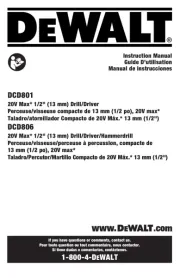
3 Augustus 2025
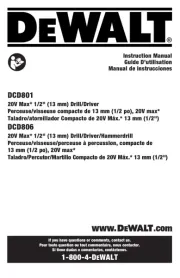
29 Juli 2025

4 Juli 2025
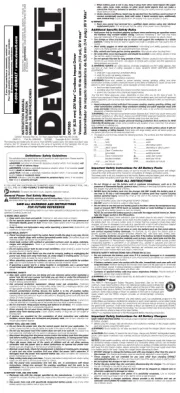
10 Juni 2025

2 Januari 2025

22 November 2024

15 November 2024

2 November 2024

23 September 2024

11 September 2024
Handleiding Boormachine
- Tryton
- Kreg
- RUKO
- Powerplus
- Makita
- Meec Tools
- Defort
- Laserliner
- Texas
- Ozito
- Netter Vibration
- Spit
- Smart365
- Herkules
- G-Technology
Nieuwste handleidingen voor Boormachine
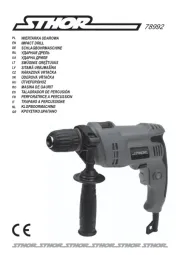
13 September 2025
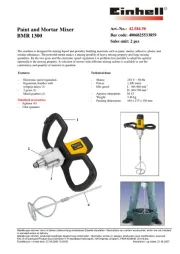
13 September 2025
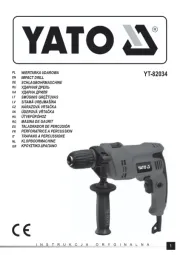
12 September 2025
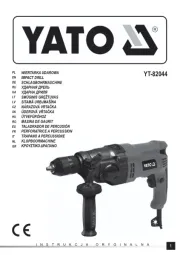
12 September 2025
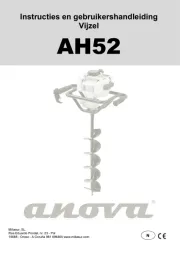
9 September 2025
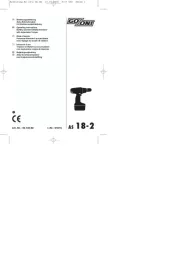
8 September 2025
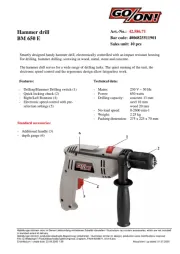
7 September 2025
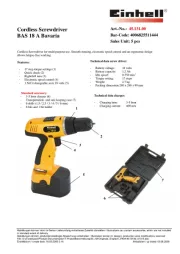
2 September 2025
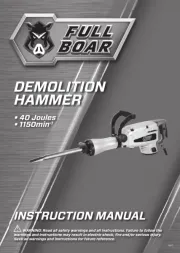
2 September 2025
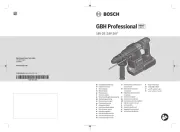
2 September 2025